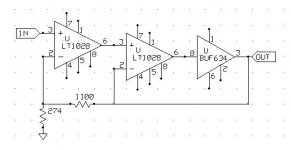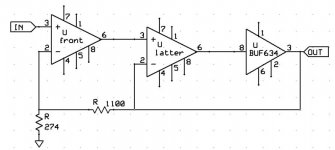As I saw the introduction of nested feedback from Douglas book
so i tried to build the circuit like in the schematics
with +-17V supply.
but in real test,
even if the input is GND,
the output may not be 0V.
With different opamp the DC will change to different values,
and the output waves may not be stable or normal.
Some combinations work fine some do not.
I would like to ask if this one is really work.
Or if there are some better nested opamp circuit.
Thanks.
Attachments
Last edited:
I wouldn't build it with the 2nd LT1028 servoing the buffer, even if compensated properly it is unlikely to improve circuit practical performance until you address lots of other issues
Spice models in general are often poor but if you pay attention to their limitations (and sometimes modify models yourself) you can get indications of loop stability issues
oddly LTSpice seems to have dropped the LT1028 comp pins in later releases of their .lib so you can't sim with required added unity gain compensation components
its good to understand the theory, how apply datasheet numbers, graphs and have a model in Spice since physical implementation can just be built wrong or poorly
with the 1st 2 "working" examples you can go back and forth with them and the physical build
Spice models in general are often poor but if you pay attention to their limitations (and sometimes modify models yourself) you can get indications of loop stability issues
oddly LTSpice seems to have dropped the LT1028 comp pins in later releases of their .lib so you can't sim with required added unity gain compensation components
its good to understand the theory, how apply datasheet numbers, graphs and have a model in Spice since physical implementation can just be built wrong or poorly
with the 1st 2 "working" examples you can go back and forth with them and the physical build
Thanks everyone!!
actually I have tried other combinations of opamps included the followings
OPA2604 opa2111 opa2107 lme49710 lme49720 opa1642 opa1612
So now i should find a unity stable opamp for the latter opamp?
then the former one i can use most of the opamp?
I would give a try soon.
Will keep updated.
actually I have tried other combinations of opamps included the followings
OPA2604 opa2111 opa2107 lme49710 lme49720 opa1642 opa1612
So now i should find a unity stable opamp for the latter opamp?
then the former one i can use most of the opamp?
I would give a try soon.
Will keep updated.
Thanks again for replies.
I have tried several combinations following and only one is stable.
front + latter
1. opa2111 + opa2111 only this one stable
2. opa2111 + LT1128 No DC but unstable output
3. opa2604 + LT1128
4. opa1642 + LT1128
5. LT1128 + opa2111
6. lme47920 + opa2111
7. opa2111 + lme47920
with these results,
how could I know which opamp can be used at which place?
should i change the values of the resistors?
Attachments
What are you hoping to achieve with such a complex design?
lower distortion and DC
as for BUF634 itself output 0.05V
and it sounds quite rough...
so the idea is adapting unity gain to complete feedback all dc and distortion
with this low distortion back to the front opamp for low distortion amplification
I knew this idea from Douglas book so I gave it a try
if separating front and unity gain part it should work well
but the idea is this loop will give even lower distortion, if work.
Member
Joined 2009
Paid Member
Low distortion is desirable because you're of the belief that lowest distortion sounds best? Or because you're designing test equipment?
The guy just wants some help with opamps -why this age-old quiz ?
Curiosity about the intended application of the circuit.
I would like to try how it may sound for lower distortion.
and it will be use for testing in some ways.
Well low distortion maybe achieved by simply using low distortion opamps or buffer like LME49600/49610.
But I have a number of BUF634 and I dont want to waste them.
Thank you Bigun.
A newbie here.
I would like to try how it may sound for lower distortion.
and it will be use for testing in some ways.
Well low distortion maybe achieved by simply using low distortion opamps or buffer like LME49600/49610.
But I have a number of BUF634 and I dont want to waste them.
Thank you Bigun.
A newbie here.
Use them in a loop with AD797, LME family etc. You just might find the increased current drive capability sounds nice. If you do that also try lowering the input impedance of the power amplifier.
I don't recommend LT1028, AD797 to beginners - too fast and twitchy, lots of design, construction and measurement detail to master
both fast enough that you can even have trouble from some buffer IC adding phase shift to the loop
hopeless to use them in a proto strip board - even sockets can compromise their stability
and their low input noise feature is often lost in circuits with too high source and feedback Z
later, better IC process op amps can be safer since they don't push the inherently faster more modern fab technology as close to the limits as the 1028 and 797 had to to get the speed decades ago
and smt only packaging can be a good thing - lower parasitics and less temptation to use inadequate prototyping boards
both fast enough that you can even have trouble from some buffer IC adding phase shift to the loop
hopeless to use them in a proto strip board - even sockets can compromise their stability
and their low input noise feature is often lost in circuits with too high source and feedback Z
later, better IC process op amps can be safer since they don't push the inherently faster more modern fab technology as close to the limits as the 1028 and 797 had to to get the speed decades ago
and smt only packaging can be a good thing - lower parasitics and less temptation to use inadequate prototyping boards
Last edited:
I don't recommend LT1028, AD797 to beginners - too fast and twitchy, lots of design, construction and measurement detail to master
both fast enough that you can even have trouble from some buffer IC adding phase shift to the loop
hopeless to use them in a proto strip board - even sockets can compromise their stability
and their low input noise feature is often lost in circuits with too high source and feedback Z
later, better IC process op amps can be safer since they don't push the inherently faster more modern fab technology as close to the limits as the 1028 and 797 had to to get the speed decades ago
and smt only packaging can be a good thing - lower parasitics and less temptation to use inadequate prototyping boards
Thanks.
So which models would you suggest then?
There really is no need to have a front op amp, it will be equally good or even better with just one op amp driving the BUF 634 with feedback going straight into the inverting input. With OPA134 it is hard to go wrong, and you will have better RFI behaviour than with a bipolar input op amp.
at audio line level I'd use a fet input type
TL072 can be fine as an input op amp in a composite amp as long as the output isn't required to do much, TL072, LF411 and similar generation are very cheap but very old
better output stages, more modern processes seem to come at a pretty steep cost increase
still rather old but as expensive as some of the newer chips: OPA2604, OPA2134, LT1022...
the OPA627 is legendary in audio but very pricey - often faked don't even think about buying on eaby
I've used AD8610, today I'd try OPA1642 series for many audio applications
TL072 can be fine as an input op amp in a composite amp as long as the output isn't required to do much, TL072, LF411 and similar generation are very cheap but very old
better output stages, more modern processes seem to come at a pretty steep cost increase
still rather old but as expensive as some of the newer chips: OPA2604, OPA2134, LT1022...
the OPA627 is legendary in audio but very pricey - often faked don't even think about buying on eaby
I've used AD8610, today I'd try OPA1642 series for many audio applications
- Status
- This old topic is closed. If you want to reopen this topic, contact a moderator using the "Report Post" button.
- Home
- Source & Line
- Analog Line Level
- Nested opamp circuit... does it really works


